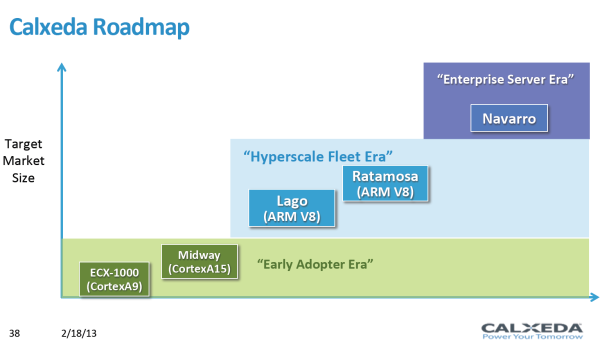Calxeda's ARM server tested
by Johan De Gelas on March 12, 2013 7:14 PM EST- Posted in
- IT Computing
- Arm
- Xeon
- Boston
- Calxeda
- server
- Enterprise CPUs
Pricing
So how much does this Boston Viridis server cost? $20,000 is the official price for one Boston Viridis with 24 nodes at 1.4GHz and 96GB of RAM. That is simply very expensive. A Dell R720 with dual 10 gigabit, 96GB of RAM and two Xeons E5-L2650L is in the $8000 range; you could easily buy two Dell R720 and double your performance. The higher power bill of the Xeon E5 servers is that case hardly an issue, unless you are very power constrained. However, these systems are targeted at larger deployments.
Buy a whole rack of them and the price comes down to $352 per server node, or about $8500 per server. We have some experience with medium quantity sales, and our best guess is that you get typically a 10 to 20% discount when you buy 20 of them. So that would mean that the Xeon E5 server would be around $6500-$7200 and the Boston Viridis around $8500. Considering that you get an integrated (5x 10Gbit) switch and a lower power bill with the Boston Viridis, the difference is not that large anymore.
Calxeda's Roadmap and Our Opinion
Let's be clear: most applications still run better on the Xeon E5. Our CPU benchmarks clearly indicate that any application that accesses the memory frequently or that needs high per thread integer processing power will run better on the Xeon E5. Compiling and installing software simply feels so much faster on the Xeon E5, there is no need to benchmark.
There's more: if your performance requirements are higher than what a quad-core Cortex-A9 can deliver, the Xeon E5 is a lot more flexible and a better choice in most cases. Scaling up is after all a lot easier than using load balancers and other complex software or hardware to scale out. Also, the management software of the Boston Viridis does the job, but Dell's DRAC, HP ILO, and Supermicro's IM are more user friendly.
Calxeda is aware of all this, as they label their first "highbank" server architecture with the ECX-1000 SoC as targeted to the "early adopter". That is why we deliberately tested a scenario that would be relevant to the potential early adopters: a cluster of web servers that is relatively network intensive as it serves a lot of media files. This is one of the better scenarios for Calxeda, but not the best: we could imagine that a streaming server or storage server would be an even better fit. Especially the latter catches on, and the storage version of the Boston Viridis sells well.
So on the one hand, no, the current Calxeda servers are no Intel Xeon killers (yet). However, we feel that the Calxeda's ECX-1000 server node is revolutionary technology. When we ran 16 VMs (instead of 24), the dual low power Xeon was capable of achieving the same performance per VM as the Calxeda server nodes. That this 24 node system could offer 50% more throughput at 10% lower power than one of the best Xeon machines available was honestly surprising to us. 8W at the wall per server node—exactly what Calxeda claimed—is nothing short of remarkable, because it means that the 48 server node machine, which is also available, is even more efficient.
To put that 8W number in perspective, the current Intel Atoms that offer similar performance need that kind of power for the SoC alone and are baked with Intel's superior 32nm process technology. The next generation ARM servers are already on the way and will probably hit the market in the third quarter of this year. The "Midway" SoC is based on a 28nm (TSMC) Cortex-A15 chip. A 28nm Cortex-A15 offers 50% higher single-threaded integer performance at slightly higher power levels and can address up to 16GB of RAM. With that it's safe to conclude that the next Calxeda server will be a good match for a much larger range of applications--memcached, larger web, and midrange database servers for examples. By then, virtualization will be available with KVM and Xen, but we think virtualization on ARM will only take off when the ARM A57 core with its 64-bit ARM V8 ISA hits the market in 2014.
Right now, the limited performance of the individual server nodes makes the Boston Viridis attractive for web applications with lower CPU demands in a power constrained data center. But the extremely low energy consumption and the rapidly increasing performance of the ARM cores show great potential for Calxeda's technology. Short term, this is a niche market, but in another year or two this style of approach could easily encroach on Intel's higher end markets.











99 Comments
View All Comments